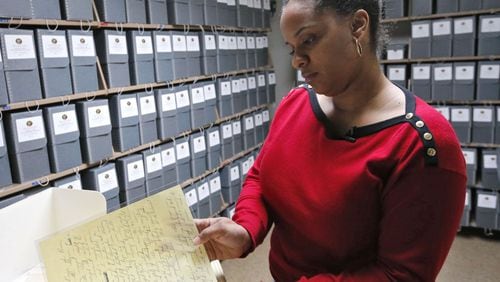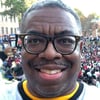In the deepest recess of the Atlanta University Center’s Robert W. Woodruff Library, chief archivist Andrea Jackson scans herself into what is commonly known as “the vault.”
Against the front wall is a massive bookshelf – containing about 1,100 books that once belonged to Martin Luther King Jr.
Books authored by greats like Hughes and Steinbeck and Gandhi. And works on philosophy, politics, religion and even algebra. Jackson glances away from the bookshelf and eyes another door.
“Want to see the good stuff?”
Another security scan into a smaller room.
It is about 65 degrees inside with the humidity hovering around 36 percent. Every shelf is stuffed with medium-sized boxes containing what many scholars consider one of the definitive collections of the work of Martin Luther King Jr., spanning from 1944 to his death in 1968.
Drafts of famous and lesser-known speeches. Hand-written letters. A telegram from Malcolm X. Even old Morehouse College report cards.
Jackson pulls out one of her favorite boxes, which contains several typed and hand-written drafts of what would ultimately become King’s 1964 Nobel Peace Prize acceptance speech. Sheets of faded notebook paper hold King’s thinking, complete with edits, scribbles and coffee stains.
“I am a lover of history and I studied history, so to touch this is a dream come true,” said Jackson, a graduate of Spelman College and New York University, who has worked at Woodruff for 10 years now. “These papers really show that Dr. King was not just smart on his own, he was a real student.”
Scholar, activist, human being
This year marks 10 years since former Atlanta Mayor Shirley Franklin hatched a $32 million idea to purchase the 13,000-piece papers directly from the King family, just days before the collection was set to be auctioned off in pieces at Sotheby’s.
As part of the deal, Morehouse College, where King attended school, would own them; Woodruff would maintain the papers, and the new Center for Civil and Human Rights would serve as the primary exhibitor.
“It is a collection to be studied,” said Vicki Crawford, the director of the Morehouse College Martin Luther King, Jr. Collection. “There is great depth and breath here. It is possible to build an entire curriculum around this collection. A lifetime that we have only begun to peel it back.”
When the Center for Civil and Human Rights opened in June 2014, it was clear that the King papers would be the centerpiece. In an intimate exhibit hall on the bottom floor of the CCHR, visitors are greeted with a huge back wall reading, “I Have a Dream,” in dozens of languages.
"He is certainly reaching some new folks," said King's youngest daughter, Bernice King, the CEO of the King Center. "I don't think I have seen this much interest in my father's work. And it has only been heightened by what has been going on in the world over the last four or five years. There is a heightened interest in King beyond 'I Have a Dream."
The King Center will be one of a number of Atlanta organizations celebrating on Monday the national holiday established in honor of King's birthday.
Only a fraction of the massive King papers collection can be displayed at any one time, so it changes every quarter.
“What we have found is the papers have provided authenticity to the center,” said CCHR executive vice president Deborah Richardson about the museum’s first acquired exhibit. “People know Dr. King as an orator and speaker, but to see his words and follow his thinking as a scholar and activist provides grounding not just for the civil rights movement, but social change. It also shows the fullness of him as a human being.”
Richardson said that while the King papers are the most popular feature in the CCHR it is hard to gauge exactly how many people have come by to see them.
Nicole Moore, the museum’s manager of interpretation and school programs, said that between August and December of 2015, more than 10,000 school children visited the exhibit.
On Wednesday, dozens of students flowed into the softly-lit room to look at the latest exhibit, “King and Youth Involvement in the American Civil Rights Movement,” which traces the response of his 1958 stabbing in Harlem through the sit-in movement through his struggles to get through to a new generation of more radical activists shortly before his death a decade later.
“Personally, this has been really cool,” said Moore, who was trained as a colonial antebellum historian, but who now has the massive task of interpreting King’s works. “I was talking to someone the other day when it struck me about how important this is. I curate Dr. King’s papers. How many people can say that?”
“A voice, a vision and a way”
Not many. But over at Morehouse, Crawford finds herself in that exclusive club.
Shortly after the papers were acquired, Morehouse established the office and hired her as co-director with King scholar Clayborne Carson, who has since returned to Stanford University full-time.
The King collection is the most studied collection in the Woodruff archive that includes, among others, the papers of Maynard Jackson, C. Eric Lincoln and Tupac Shakur.
Crawford recently entered into an agreement with University of Georgia Press to publish short books by emerging scholars on contemporary issues, through the gaze of the King papers.
“King always loomed large to me. The history is around you every day,” said Crawford, a civil rights scholar who grew up in Atlanta and counted the children of the Lowerys, Youngs and Abernathys as her circle of friends. “I have a deep appreciation for the complexity of Dr. King. He offers a voice, a vision and a way.”
While Crawford grew up in a world dominated by King, she references a recent study that suggests that while current students are taught about civil rights, they actually know very little about the movement, aside from King or Rosa Parks.
The King papers partially addresses that. Access to the papers is easy and readily available in digital form within the archive. Several Morehouse professors have also incorporated the study of the papers as primary sources into their curriculum.
“I try to use the collection to show that one of the most potent American exports of the 20th Century was not the iPhone or the Corvette, but the idea of nonviolent direct action,” said Morehouse history professor and photojournalist Larry Spruill. “It showed that we can change society with a deliberate effort to demonstrate nonviolence. So how does King go from a Baptist preacher to a global figure in 1968? Those are the global and conceptual questions that are worth studying.”
The March 21 documentary 'The Last Days of Dr. Martin Luther King Jr.' on Channel 2 kicked off a countdown of remembrance across the combined platforms of Channel 2 and its partners, The Atlanta Journal-Constitution and WSB Radio.
The three Atlanta news sources will release comprehensive multi-platform content until April 9, the anniversary of King’s funeral.
On April 4, the 50th anniversary of Dr. King’s assassination, the three properties will devote extensive live coverage to the memorials in Atlanta, Memphis and around the country.
The project will present a living timeline in real time as it occurred on that day in 1968, right down to the time the fatal shot was fired that ended his life an hour later.
The project will culminate on April 9 with coverage of the special processional in Atlanta marking the path of Dr. King’s funeral, which was watched by the world.







